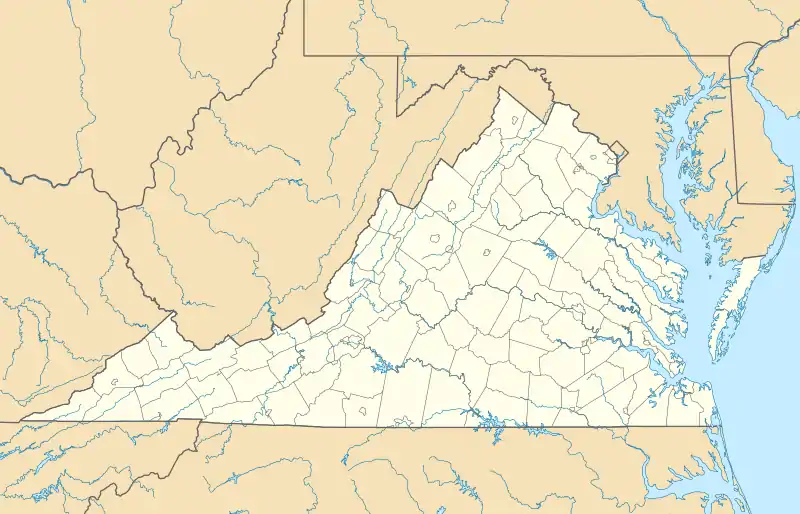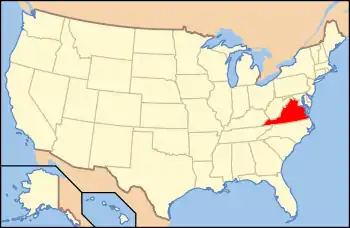Bellwood (Richmond, Virginia)
Bellwood, also known as Auburn Chase, New Oxford, Sheffield, and Defense Supply Center Richmond Officers' Club-Building 42, is an historic plantation house located near Richmond in Chesterfield County, Virginia.
Bellwood | |
  | |
| Nearest city | Richmond, Virginia |
|---|---|
| Coordinates | 37°24′55″N 77°26′10″W |
| Area | 21 acres (8.5 ha) |
| Built | c. 1804 |
| NRHP reference No. | 78003013[1] |
| VLR No. | 020-0007 |
| Significant dates | |
| Added to NRHP | December 12, 1978 |
| Designated VLR | June 19, 1973, September 22, 2011[2] |
Bellwood was built on land formerly owned by the Seth Ward family. Judge Richard Ward, son of the original Seth Ward immigrant, purchased 1,337 acres on the James River at the mouth of Falling Creek from Jeremiah Blackman in 1665 and established Sheffield Plantation. Five subsequent generations of first born sons named Seth were raised at Sheffield. Seth Ward V sold the property to his aunt and uncle, Mary Ann Ward and Richard Claiborne Gregory in 1797. Richard Claiborne Gregory's son, Richard Augustus Gregory 1795-1835 built the house now known as Bellwood about 1804. It is a two-story, five bay, timberframe I-house dwelling with a low hipped roof in the Georgian style. The house is set on brick foundations and sheathed in weatherboard.
In 1847, the plantation passed through inheritance to Gregory's daughter Lavinia and her husband, Chesterfield Justice Augustus Drewry. At the outbreak of the Civil War, Drewry was commissioned as commander of Company C, 2nd Regiment Virginia Artillery, CSA and helped construct a fort on the edge of the property known as Drewry's Bluff, or Fort Darling.[3] The fort overlooked the James River and had 3 large guns (1 ten-inch and 2 eight-inch columbiads),[4] the installation of which was overseen by General Robert E. Lee's eldest son Brigadier General G.W.C. Lee.[5] The fort along with ships sunk in the river channel below Drewry's bluff to create obstructions were intended to prevent Union gunboats from reaching the Confederate Capitol, Richmond.
On May 15, 1862 in the Battle of Drewry's Bluff the guns of Fort Darling successfully held off an attempt by the Union warships Monitor and Galena to steam upriver to Richmond and later, repelled an attack by land. Drewry’s regiment was broken up soon after the battle, but he was promoted to Major shortly afterward for his actions during the battle that seriously damaged the Galena forcing the Union ironclads to retreat.
In May 1864, Confederate General P.G.T. Beauregard made the site his headquarters and met with Confederate President Jefferson Davis in the manor house to discuss plans for halting the Union's advance on Richmond. After the war, Drewry traded the farm to Captain James Jones and moved to Westover in Charles City county where he lived until his death in 1899. Jones wasn't successful at farming, since the land had been worn out from over two centuries of mono-culture tobacco and cotton crops.[3]
In 1887, the house and farmlands were acquired by James Bellwood, a Canadian farmer. Bellwood paid $18.50 per acre for approximately 2,000 acres of land and made the manor house his home and the property became known as "Bellwood Farms". To restore the productivity of the depleted soil, Bellwood introduced crop rotation, used mulching and natural fertilizers and installed miles of drainage tiles and levees making the farm one of Virginia's chief agricultural showplaces. James Bellwood won many awards for his crops and livestock at the Panama-Pacific International Exposition in San Francisco in 1915. He grew different varieties of grains, grasses and forage crops and also operated a large dairy farm which supplied milk to Richmond markets. He had a herd of over 1,000 Holstein cattle and a prize herd of beef cattle.[3] Bellwood, a native of Canada, missed the elk from his homeland and imported a breeding pair of elk and created an elk herd on the property.
James Bellwood died in 1924 and his descendants continued the agricultural operation through the 1930s. In 1941, 631 acres of the Bellwood property including the manor house, a large dairy barn and several outbuildings were acquired from his heirs by the U.S. Government to construct the Department of Defense General Supply Center. One of the stipulations of the sale was that the Army agree to look after the elk herd and they have done so ever since. The dairy barn was demolished in 1947 but the antebellum manor house is maintained as the center's officers' club.[6]The property also contains the Gregory Family cemetery, the historic elk pasture created by James Bellwood, and two feeding stations for the elk.
It was listed on the National Register of Historic Places in 1978.[1] A boundary increase was proposed in 2011.
References
- "National Register Information System". National Register of Historic Places. National Park Service. July 9, 2010.
- "Virginia Landmarks Register". Virginia Department of Historic Resources. Archived from the original on 21 September 2013. Retrieved 5 June 2013.
- "Installation History". www.dla.mil. Defense Logistics Agency. Retrieved 28 September 2020.
 This article incorporates text from this source, which is in the public domain.
This article incorporates text from this source, which is in the public domain. - "Drewry's Bluff". www.nps.gov. Retrieved 18 November 2012.
- "The Battle of Fort Darling/Drewry's Bluff (First)". www.mycivilwar.com. Retrieved 18 November 2012.
- Virginia Historic Landmarks Commission Staff (November 1974). "National Register of Historic Places Inventory/Nomination: Bellwood" (PDF). Virginia Department of Historic Resources., Jeanne Barnes (May 2011). "National Register of Historic Places Inventory/Nomination: Bellwood, 2011 Update and Boundary Expansion" (PDF). Virginia Department of Historic Resources., and Accompanying five photos

